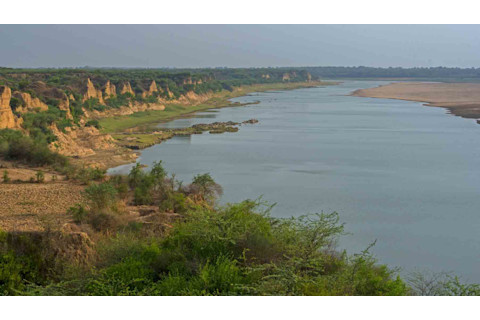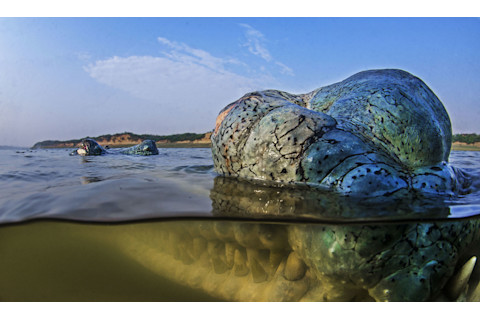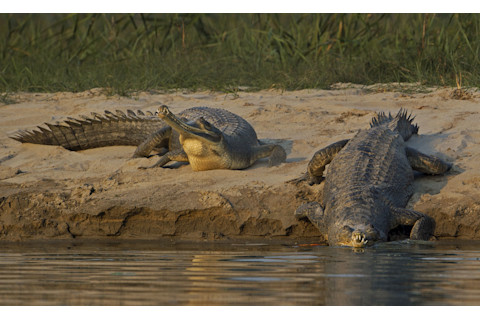Dead gharials began washing up on the banks of India’s Chambal River in December 2007. Over the following weeks, the body count grew. By mid-January, the dead reptiles—some the length of two tall men, lined up end to end—numbered in the dozens. By March, more than 110 of the skinny-snouted creatures had been found dead, most along a 30-kilometer (18-mile) stretch of river.
At the time, there were thought to be just 200 to 250 breeding-age gharials (Gavialis gangeticus) left in the world. And while only a dozen or so of the victims had reached reproductive age, many were close. A loss of more than 100 of them represented a major blow for a population already in crisis. Having been classified by the International Union for Conservation of Nature (IUCN) as critically endangered even before the die-off began, the species was clearly in trouble—including here on the Chambal, its last remaining stronghold.
Among the international team of veterinarians and crocodile experts that convened to investigate was Jeffrey Lang, a conservation biologist previously at the University of North Dakota. When Lang traveled to India that March, he was concerned about the die-off. But he was also driven by what he saw as a window of opportunity, opened by the crisis, to take a closer look at an understudied species. What he found were questions, loads of them—not just about what was killing gharials, but about how the animals lived in the first place.
“We opened a Pandora’s box. There was all this stuff we didn’t know,” says Lang, now a scientific advisor for the Madras Crocodile Bank Trust and the Gharial Conservation Alliance. To help fill the many knowledge gaps surrounding these imperiled creatures, Lang—along with conservationist Rom Whitaker and croc researcher Dhruvajyoti Basu—launched a research project on the Chambal that would reveal many new details about basic gharial natural history and ecology, from their movements and breeding behaviors to the many threats they face over the course of their lives.
Even as the mystery lingered over the 2008 die-off, study results began to provide clues about how best to protect the gharial—both from the potential for similar catastrophes and from the growing pressure of development that threatens the species’ very existence.

Surrounded by box canyons and dry scrub, India's Chambal River provides critical habitat for a wide variety of wildlife, including several endangered species. (Credit: Dhritiman Mukherjee)
Dhritiman Mukherjee
Surrounded by box canyons and dry scrub, India’s Chambal River provides critical habitat for a wide variety of wildlife, including several endangered species. (Credit: Dhritiman Mukherjee)
A Miniature Grand Canyon
The Chambal River stretches some 600 miles through three states in northern India. It drains into the Yamuna River, a main tributary of the Ganges. Surrounding the river is a region of steep bluffs, box canyons, and ravines—a blazing-hot desert dominated by thorny scrub not unlike the Badlands of South Dakota.
According to ancient Indian legend, thousands of cows were once slaughtered along the banks of the Chambal, causing the river to run red with blood. Because of this, unlike other major rivers in India, the Chambal has long been considered unholy. That belief has deterred development along the river and left the ecosystem here relatively pristine. Few roads lead to the water and few bridges cross it, despite the fact that it flows through one of the most densely populated regions of the world. What’s more, since 1979, more than two-thirds of the river has been designated a sanctuary to protect South Asian river dolphins (Platanista gangetica), red-crowned roofed turtles (Batagur kachuga), gharials, and other wildlife that nest along its wide, sandy banks during the dry season.
Along the Chambal, Lang says, it’s still possible to find solitude—and intrigue. In addition to being a safe haven for wildlife, the area is an infamous refuge for bandits, including a female Robin Hood-type gang leader who was arrested in the 1980s, later elected to Parliament, and featured in an award-winning 1994 film called The Bandit Queen.
“The Chambal is a uniquely stark and dangerous-looking landscape, especially if you know the history,” Whitaker says. “Walking through the tall ravines is a bit like traversing a miniature Grand Canyon, with a bit of an extra edge knowing you are in leopard, cobra, and viper country.”

The back of an adult male — likely these hatchlings’ father — provides both protection and a convenient place to bask in the sun. (Credit: Dhritiman Mukherjee)
Dhritiman Mukherjee
The back of an adult male — likely these hatchlings’ father — provides both protection and a convenient place to bask in the sun. (Credit: Dhritiman Mukherjee)
A Croc Parental Cooperative
Even within that wild land, it is easy to recognize a gharial. Among the largest crocodilians in the world, gharials have long, heavy bodies and relatively small heads with bulging eyes and skinny snouts. Although their rows of pointy teeth look menacing, they are specialized for catching and holding onto fish, and pose little danger to people.
The creature’s most peculiar feature is the male gharial’s ghara — a spherical and flexible lump of cartilage near the end of its snout that grows as an extension of the nasal chamber after males reach a length of 4.5 meters (14 feet) or so. Researchers don’t yet know what function the ghara serves, but one theory is that it somehow helps to amplify hissing and underwater popping sounds that, according to recent research, help males establish and maintain breeding territories and entice females into courtship.
Despite their distinctive physical traits, relatively little was known about the lives or biology of gharials when Lang began studying them in 2008. For years, he and colleagues had been trying, without luck, to gain permission from the Indian government to put radio tags on crocodilians in the area. But concerns about disturbing the reptiles and tampering with nature contributed to a reluctance to authorize their capture for research. With the die-off came a new sense of urgency, and in 2008 and 2009, the researchers finally got their chance to tag 10 gharials. By the spring of 2017, they had tagged 35 individuals, and had followed the movements of each animal for up to two years.
Results have provided a variety of basic information about the species — much of it carrying conservation implications. Mid-sized gharials (which were, strangely, the only ones affected by the die-off), for example, rarely travel more than 20 to 30 kilometers (12 to 18 miles) from their home base, and they usually cover less ground than that. According to Lang, this suggests that the die-off likely resulted from a single, localized toxic source, as opposed to more widespread river pollution.
In contrast, larger adult gharials typically swim long distances — as much as 200 kilometers (125 miles) or more each season. That scale of migration underscores the need to view conservation of the species through a wide lens. These long migrations, Lang says, tie the whole river together. “You can’t put dams and barrages and structures on the river.”
Other research sparked by the die-off — and funded in large part by the international zoo community — has revealed surprising and elaborate parental-care behaviors among gharials. After hatching on the river’s sandy banks just before the rainy season begins in July, hundreds to more than a thousand little gharials typically gather in one place. Multiple mothers of this mixed brood take turns checking on the hatchlings day and night, protecting the babies from herons and other predators. When dangers mount, a single male may join in on the defense effort. This vigil will last until the young finally disperse as September’s monsoon rains cause the Chambal to swell once again.
While this annual cycle still occurs today, what remains unclear is what the future holds for a species that, over the last half century, has been defined by precipitous declines.

One of the most distinguishing characteristics of the gharial is the ghara, the bulbous lump at the end of the snout. This growth, which is only present on males, is thought to amplify the hissing and underwater popping sounds that males make when defending their territories. (Credit: Dhritiman Mukherjee)
Dhritiman Mukherjee
One of the most distinguishing characteristics of the gharial is the ghara, the bulbous lump at the end of the snout. This growth, which is only present on males, is thought to amplify the hissing and underwater popping sounds that males make when defending their territories. (Credit: Dhritiman Mukherjee)
The Last Gharials on Earth
Gharials were once the most common crocodilians in the open river systems of South Asia, with as many as 40,000 or more adult gharials living in the rivers of India, Nepal, Pakistan, Bhutan, and Myanmar before the arrival of European hunters. Declines accelerated in the 1850s, with the construction of canals and other structures. By the early 1940s, gharial numbers had fallen to an estimated 10,000.
Another 20 years of hunting and fishing, coupled with additional dams, irrigation projects, and other infrastructure had decimated gharial populations and damaged the species’ habitat. In the last 50 years, Lang says, the species has ceased to exist in six locations. By 2025, it’s expected to disappear from four more. Already gone from more than 90 percent of its original range, the gharial is now limited to 14 populations. Just five of these are actively reproducing. Most groups contain fewer than 50 individuals of breeding age (10 to 15 years old for females, 20 to 25 for males). Today, there are just 650 to 700 mature gharials, living only in India and Nepal.
In response to the precipitous declines, conservation efforts began in the 1970s when the Indian government formed the Chambal sanctuary and invested in a number of capture-and-release programs. These efforts aimed to boost wild populations by collecting gharial eggs and raising the young reptiles in captivity for a couple years, and that work has been critical in protecting the species from extinction, Lang says. But the practice has become controversial, particularly on the Chambal, where the discovery of large, mixed broods suggests that the young here may be better off left in the wild.
The relatively healthy breeding population on the Chambal is precisely why the massive 2008 die-off here caused such alarm. The Chambal contains nearly 80 percent of all the gharials left on Earth. It is the only population large enough to be stable, says Perran Ross, a crocodile expert at the University of Florida in Gainesville, and co-author with Lang on the latest IUCN Red List assessment, which is currently under review.
“In that one die-off, a huge proportion of what we thought were there died,” Ross says. “It’s not a good thing to lose 100 of a critically endangered species.”

Gharials bask on the wide, sandy banks of the Chambal during the dry season. (Credit: Dhritiman Mukherjee)
Dhritiman Mukherjee
Gharials bask on the wide, sandy banks of the Chambal during the dry season. (Credit: Dhritiman Mukherjee)
Mysterious Die-Offs
When gharials were dying in droves in 2008, Lang says, the most immediate concern was that the same thing would happen the next year, and the year after. In response, local veterinarians were trained to conduct autopsies and to take tissue samples from dead animals. Meanwhile, speculation ensued among researchers and government officials about what caused the die-off.
Early theories focused on widespread pollution. Based on a variety of clues, however, Lang suspects illegal or accidental dumping of the non-steroidal anti-inflammatory drug diclofenac that was once commonly used on livestock but was banned in India in 2006. A few years earlier, also in South Asia, the drug was responsible for a sharp decline of vultures, which all showed signs of kidney dysfunction like the dead gharials examined in 2008.
Definitive proof has remained elusive, and fortunately another gharial die-off has yet to come. In the meantime, as Lang and his team began to monitor various threats and population trends, they found a sign of hope: There were more gharials than they had expected to see on the Chambal. Before the die-off, annual counts by the local forest department had produced the estimated total of 200 to 250 adult gharials that was often repeated at the time. But even after more than 100 gharials died in the winter of 2008, there seemed to be plenty of the animals in the river. “That sort of opened our eyes,” Ross says, “that something was wrong with the population estimates.”
Intensive surveys since the die-off suggest that around 2,000 gharials now live on the Chambal, including breeding adults, sub-adults, and juveniles. As of 2017, there were at least 483 breeding adults living in the sanctuary alone, including 411 reproductive females and 72 large males. The population is producing thousands of young each year. And although most of those babies don’t survive to adulthood, the Chambal population is 10 times larger than the next largest breeding group of gharials. Just as significant, the population appears to be self-sustaining, and possibly growing. “The gharials are doing better than ever in my 50 years of experiencing this river,” says Whitaker, who recently spent time on the Chambal.
But threats remain, including the illegal extraction of sand and gravel to make concrete, as well as the tapping of the Chambal’s waters to irrigate seasonal crops along the riverbanks. The greatest threat, according to Whitaker, is the rising demand for water in one of the driest regions of India, home to millions of people who need the precious resource to survive. Managing this demand in order to balance the needs of people with the requirements of gharials and other wildlife in the Chambal will require creative solutions.
Although a decade has passed since 110 gharials mysteriously died here, experts know that a similar catastrophe could happen again. That possibility has added a simmering sense of urgency to research and conservation efforts along the Chambal. The die-off also illustrates the potentially catastrophic consequences that disruptions to water bodies can have on aquatic species that are close to the brink. For a species that is struggling, the fate of this river will determine its future. “If the species is going to survive,” Lang says, “it’s going to survive in the Chambal.”
This story originally appeared in bioGraphic, an online magazine featuring beautiful and surprising stories about nature and sustainability.














